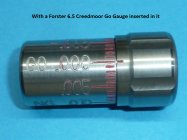jepp2
Gold $$ Contributor
Just to share my experience with my LR308. It has a Krieger barrel and I am converting to Peterson SRP brass.
I use a Whidden case gauge to measure my shoulder for sizing. On the new Peterson brass it measured 0.000 and after firing them they measured 0.0015" to 0.002". When I size I will size them back to the 0.000, same as factory new. Over time I will determine at what length I get resistance on bolt closing and record that, and I may adjust what I size to after that.
Here is the Whidden gauge measurement with a Go gauge in it.

I use a Whidden case gauge to measure my shoulder for sizing. On the new Peterson brass it measured 0.000 and after firing them they measured 0.0015" to 0.002". When I size I will size them back to the 0.000, same as factory new. Over time I will determine at what length I get resistance on bolt closing and record that, and I may adjust what I size to after that.
Here is the Whidden gauge measurement with a Go gauge in it.











